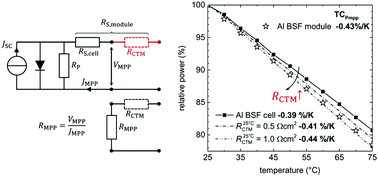The impact of silicon solar cell architecture and cell interconnection on energy yield in hot & sunny climates†
Abstract
Extensive knowledge of the dependence of solar cell and module performance on temperature and irradiance is essential for their optimal application in the field. Here we study such dependencies in the most common high-efficiency silicon solar cell architectures, including so-called Aluminum back-surface-field (BSF), passivated emitter and rear cell (PERC), passivated emitter rear totally diffused (PERT), and silicon heterojunction (SHJ) solar cells. We compare measured temperature coefficients (TC) of the different electrical parameters with values collected from commercial module data sheets. While similar TC values of the open-circuit voltage and the short circuit current density are obtained for cells and modules of a given technology, we systematically find that the TC under maximum power-point (MPP) conditions is lower in the modules. We attribute this discrepancy to additional series resistance in the modules from solar cell interconnections. This detrimental effect can be reduced by using a cell design that exhibits a high characteristic load resistance (defined by its voltage-over-current ratio at MPP), such as the SHJ architecture. We calculate the energy yield for moderate and hot climate conditions for each cell architecture, taking into account ohmic cell-to-module losses caused by cell interconnections. Our calculations allow us to conclude that maximizing energy production in hot and sunny environments requires not only a high open-circuit voltage, but also a minimal series-to-load-resistance ratio.



 Please wait while we load your content...
Please wait while we load your content...